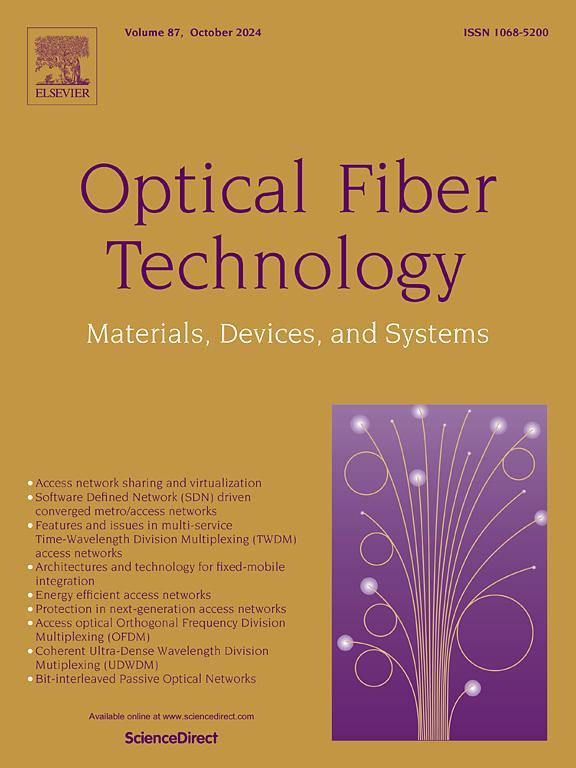不同光谱响应的d型长周期光纤光栅及其在增强扭转传感中的应用
IF 2.7
3区 计算机科学
Q2 ENGINEERING, ELECTRICAL & ELECTRONIC
引用次数: 0
摘要
在相同结构参数的d型光纤上制备了两个弧致长周期光纤光栅(LPFGs),它们分别具有一个共振倾角和两个共振倾角。通过对d型光纤的模态分析,比较了两种LPFGs的谐振耦合特性,揭示了其不同光谱响应的原因,这主要归因于制造过程中引入的扭转效应。由于结构和制作的高度不对称,两种d型LPFGs在扭转和温度测量中都具有极化依赖性能。在单倾角的d型LPFG中,顺时针和逆时针方向的高扭转灵敏度分别可达0.248 nm/(rad/m)和0.223 nm/(rad/m)。特别是共振波长的不同移位方向表明该LPFG具有分辨扭转方向的能力。相比之下,在具有两个倾角的d形LPFG中,两个共振波长都随扭转速率呈正弦变化。由于两个dip的温度灵敏度几乎相等,因此可以使用两个dip之间的波长差作为特征参数来消除温度交叉灵敏度。根据该策略,波长与扭转速率之间可以实现线性关系,扭转灵敏度达到0.352 nm/(rad/m)。两种d型lpfg的演示,有助于开发高性能的基于lpfg的扭矩传感器。本文章由计算机程序翻译,如有差异,请以英文原文为准。
D-shaped long period fiber gratings with different spectral responses and their applications in enhanced torsion sensing
We demonstrate two arc-induced long period fiber gratings (LPFGs) fabricated on the D-shaped fibers with the same structural parameter, which have a single dip and two resonance dips, respectively. By virtue of the modal analysis for the D-shaped fiber, the resonant coupling characteristics in both LPFGs are compared to reveal the reason for their different spectral responses, which are essentially attributed to the introduced twist effect in the fabrication. Due to the high asymmetry from the structure and fabrication, both D-shaped LPFGs have the polarization dependent performances in torsion and temperature measurements. In the D-shaped LPFG with a single dip, the high torsion sensitivities in the clockwise and counterclockwise directions can be up to 0.248 nm/(rad/m) and 0.223 nm/(rad/m), respectively. In particular, the different shifting directions for resonance wavelength indicate this LPFG with the capability of discriminating twist direction. By contrast, in the D-shaped LPFG with two dips, both resonance wavelengths vary sinusoidally with the twist rate. Because the temperature sensitivities of the two dips are almost equal, the temperature cross-sensitivity can be eliminated by using the wavelength difference between both dips as the characteristic parameter. According to this strategy, the linear relation between the wavelength and twist rate can be achieved with a very high torsion sensitivity of 0.352 nm/(rad/m). The demonstration of two D-shaped LPFGs is beneficial to the development of LPFG-based torsion sensors with a high performance.
求助全文
通过发布文献求助,成功后即可免费获取论文全文。
去求助
来源期刊

Optical Fiber Technology
工程技术-电信学
CiteScore
4.80
自引率
11.10%
发文量
327
审稿时长
63 days
期刊介绍:
Innovations in optical fiber technology are revolutionizing world communications. Newly developed fiber amplifiers allow for direct transmission of high-speed signals over transcontinental distances without the need for electronic regeneration. Optical fibers find new applications in data processing. The impact of fiber materials, devices, and systems on communications in the coming decades will create an abundance of primary literature and the need for up-to-date reviews.
Optical Fiber Technology: Materials, Devices, and Systems is a new cutting-edge journal designed to fill a need in this rapidly evolving field for speedy publication of regular length papers. Both theoretical and experimental papers on fiber materials, devices, and system performance evaluation and measurements are eligible, with emphasis on practical applications.
 求助内容:
求助内容: 应助结果提醒方式:
应助结果提醒方式:


